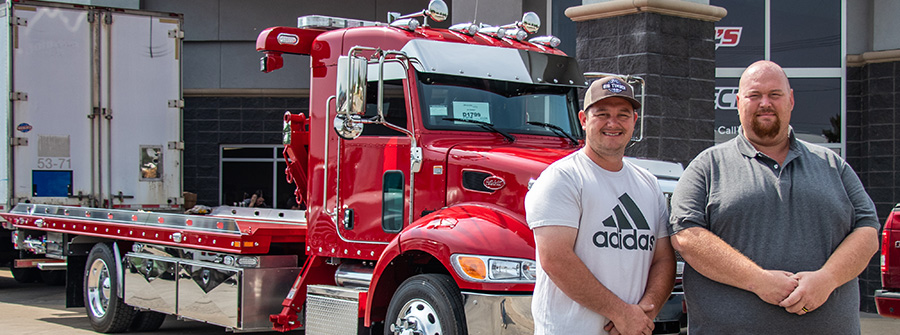by
Cameron Hanson
| Oct 09, 2019

Brothers Steve (left) and Sam McGuire drove 12 hours straight through from eastern Kentucky to New Hampton, IA, last month to pick up their new LCG 21-foot steel car carrier from Zip’s AW Direct. The Century 12 Series rollback was the family’s first purchase from us.
The brothers said they spared no expense on the exterior of the red 2020 Peterbilt and were planning to dress up the interior as well. The polished aluminum bed rails, stainless steel toolbox doors, shiny wide bumper, chrome bug shield and chrome visor were just a start, they said.
“We’re shooting to make it back home in one day, but we have to stop by the chrome shop first,” explained Sam, who described himself as the “older and prettier” of the two siblings.
“The interior is just too plain for us,” Steve joked, confirming their first stop of the return trip will be the famous Iowa 80 Truckstop two and a half hours away.
The brothers hail from McGuires Towing, a 32-year-old towing and recovery company that is now well into its second generation. They operate out of Ashland, KY, and serve the tri-state area of Kentucky, West Virginia and Ohio.
“Dad started out with just one truck in 1987 with a homebuilt bed, and we’ve kind of grown from there,” Steve said. “We’re just the next generation to keep it going.”
“It has definitely evolved over years,” Sam added. “Dad has stepped back and given us the reins.”
Their latest truck purchase joins a fleet that includes a Miller 1150 rotator, a heavy-duty straight stick, three car carriers, two tractor-trailers and other light-duty wreckers.
Besides all of the exterior jewelry on this newest addition, the lighting package--highlighted by an LED message board--is sure to grab your attention as well. There’s also an SP9000 Sidepuller, GoJaks, storage trays and synthetic winch line.
“We went a little overboard with this one,” Sam admitted. “We figured it’s just easier to do it now when it’s being built.”
The brothers said they put together their shopping list for their custom car carrier by attending various tow shows and by researching Zip’s options online. “We’ve been following your trucks on social media and on your website for a long time now,” Sam said.
Both Sam and Steve said their first time working with the staff at Zip’s AW Direct has exceeded their expectations. They were able to stay at the company’s complimentary on-site hotel suite and were very appreciative of the red-carpet treatment they received during their overnight stay here.
“This has been a great experience for us,” Steve said. “You come to a place, and you usually don’t know where to stay, where to eat or anything like that. It’s nice to come here and meet all these nice people. They treat you like family here.”
“We want to thank you guys for the hospitality,” Sam said. “We’re very grateful, and we’re definitely looking forward to doing business with you guys again.”
To see the custom truck in person, visit our booth at the Tennessee Tow Show in Chattanooga Oct. 10-12.